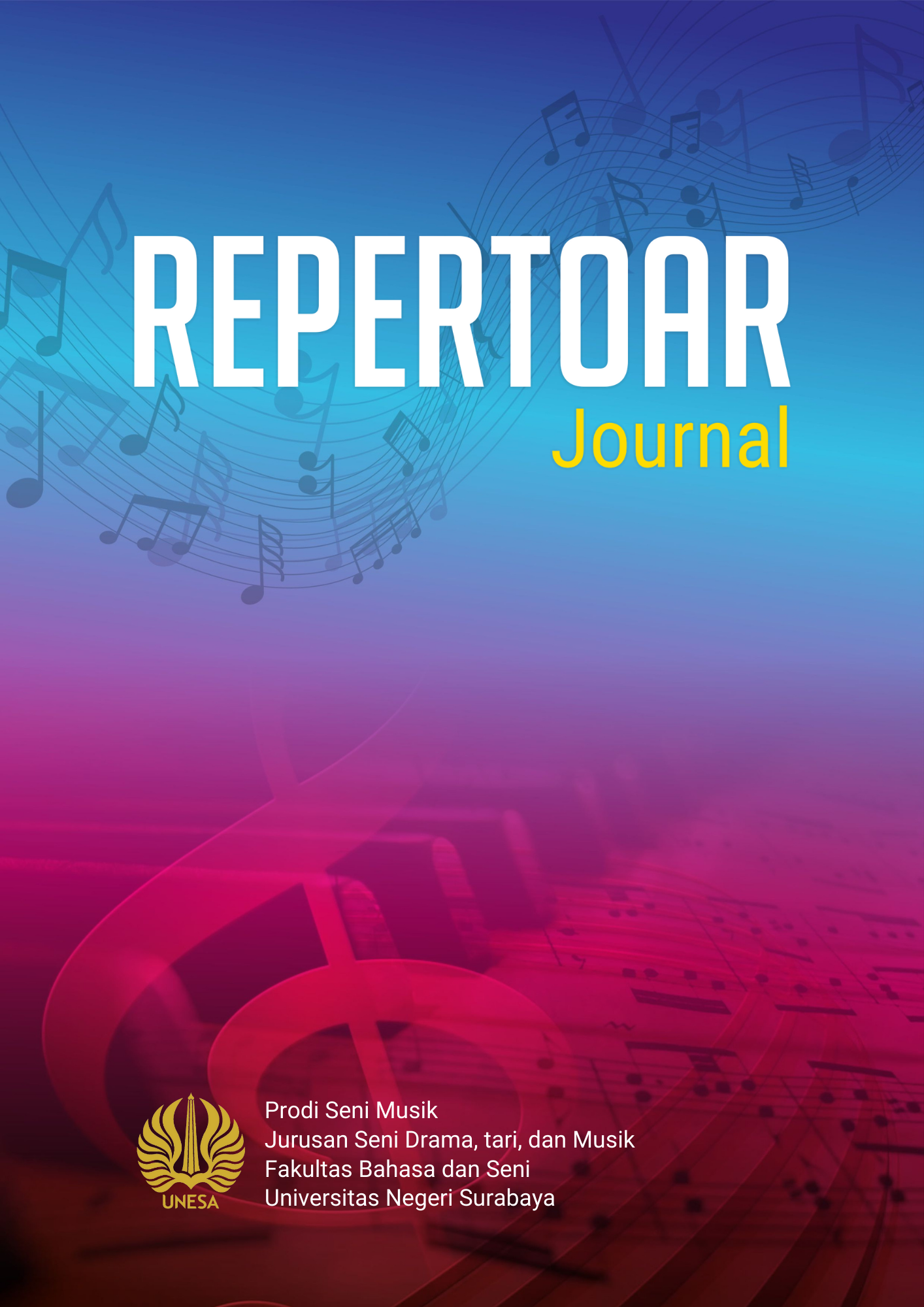Children's Song Trio As A Form Of Controlling Gadget Use In Children
Main Article Content
Abstract
Art research represents the diversity of perspectives that come from the art disciplines of each practitioner as an effort to continue to establish the principle of usefulness. Looking at the younger generation, especially children who from time to time experience changes in learning patterns to parenting patterns, art is considered capable of strengthening these patterns in order to maintain a balance so that relatively minor impacts occur. This includes the use of technology by children, which tends to be less wise, thus risking affecting their future. Technology, in this case, gadgets, has become an important tool to support children in learning. However, the use of gadgets in children is often uncontrolled due to a lack of parental supervision, so that negative impacts are very likely to occur. This control effort starts from qualitative analysis and quantitative data collection in the form of questionnaires distributed to respondents of elementary school children. Based on these efforts, valid data was found, and an agreement was made to make children's songs a tangible manifestation of efforts to control the use of gadgets in children. Children's songs are expected to be an important part of the success of a civilisation, so that children's participation continues to be optimal without being tainted by the negative impact of gadgets.
Article Details

This work is licensed under a Creative Commons Attribution-NonCommercial-ShareAlike 4.0 International License.
References
Aisyah, I. U., & Wijayani, N. Q. (2023). Penggunaan Gadget Terhadap Kualitas Tidur Dan Kesehatan Mental Remaja. Jurnal Multidisiplin Ilmu Sosial, 2(9), 31–40.
Alimuddin, J. (2015). Lagu Anak Sebagai Salah Satu Sarana Mendidik Anak. Universitas Islam Sultan Agung.
Barnadib, S. (1982). Pengantar Ilmu Mendidik Anak-Anak. Institut Keguruan dan Ilmu Pendidikan Yogyakarta.
Berniker, E. (1987). ‘Understanding technical systems’, Symposium on Management Training Programs: Implications of New Technologies, Geneva.
Darusman, C. (2017). Perjalanan Sebuah Lagu “Tentang Penciptaan, Perlindungan dan Pemanfaatan Lagu.” PT Gramedia.
Djohan. (2003). Psikologi Musik. Buku Baik Yogyakarta.
Djohan. (2009). Psikologi Musik “Cetakan Ketiga – Edisi Revisi.” Galangpress.
Garini. (2013). “GADGET” Positif dan Negatif. PT Raja Grafindo Persada.
Hurlock, E. B. (1978). Perkembangan Anak Jilid II. Erlangga.
Kusumawati, H. (2013). Pendidikan Karakter Melalui Lagu Anak-anak. Universitas Negeri Yogyakarta.
Kusumawati, H. (2019). Lagu Anak Berbahasa Indonesia dalam Perpektif Pendidikan. Universitas Gadjah Mada.
Luxemburg, J. Van. (1989). Pengantar Ilmu Sastra. PT Gramedia Pustaka Utama.
M. Yemmardotillah, R. I. (2021). Literasi Digital Bagi Keluarga Milenial Dalam Mendidik Anak Di Era Digital. Continuous Education: Journal of Science and Research, 2(2), 1–13. https://doi.org/10.51178/ce.v2i2.223
Mack, D. (2001). Pendidikan Musik Antara Harapan dan Realita. Universitas Pendidikan Indonesia.
McNiff, J. (1988). Action Research: Principles and Practice. Macmillan.
Muliati, B., & Sari, R. (2018). Melalui Lagu-Lagu Patriotik Bagi Peserta Didik. Jurnal Al–Hikmah Vol., 6(1), 1–11.
Nur, S. A., Mahya2, A. F. P., & Santoso3, G. (2022). Revolusi Pendidikan di Era Society 5.0; Pembelajaran, Tantangan, Peluang, Akses, Dan Keterampilan Teknologi. Jurnal Pendidikan Transformatif (Jupetra), Vol. 01 No, 18–28.
Nurkhomah, H. (2020). Karakteristik Lagu Anak-Anak Karya Titiek Puspa. Jurnal Pendidikan Musik, 6(6), 376–383.
Rahmah, A. (2015). Digital Literacy Learning System for Indonesian Citizen. Procedia Computer Science, 72, 94–101. https://doi.org/10.1016/j.procs.2015.12.109
Roger, E., Storey, J., Berger, C., & Chaffee, S. (1987). Communication Campaigns (In: Handbo). Sage.
Sanjaya, R. M. S. (2013). Metode Lima Langkah Aransemen Musik. Promusika, 1, 33–49. https://doi.org/10.24821/promusika.v0i0.538
Santosa. (2012). Komunikasi Seni “Aplikasi dalam Pertunjukan Gamelan.” Institut Seni Indonesia Surakarta.
Stephanus Turibius Rahmat. (2019). Pola Asuh Yang Efektif Untuk Mendidik Anak Di Era Digital. Jurnal Pendidikan Dan Kebudayaan Missio, 10(2), 143–161. https://doi.org/10.36928/jpkm.v10i2.166
Sugiyono. (2009). Metode Penelitian Pendidikan Pendekatan Kuantitatif, Kualitatif, dan R&D. Alfabeta.
Suminto, A. S. (1985). Puisi dan Pengajarannya. IKIP Semarang Prees.

